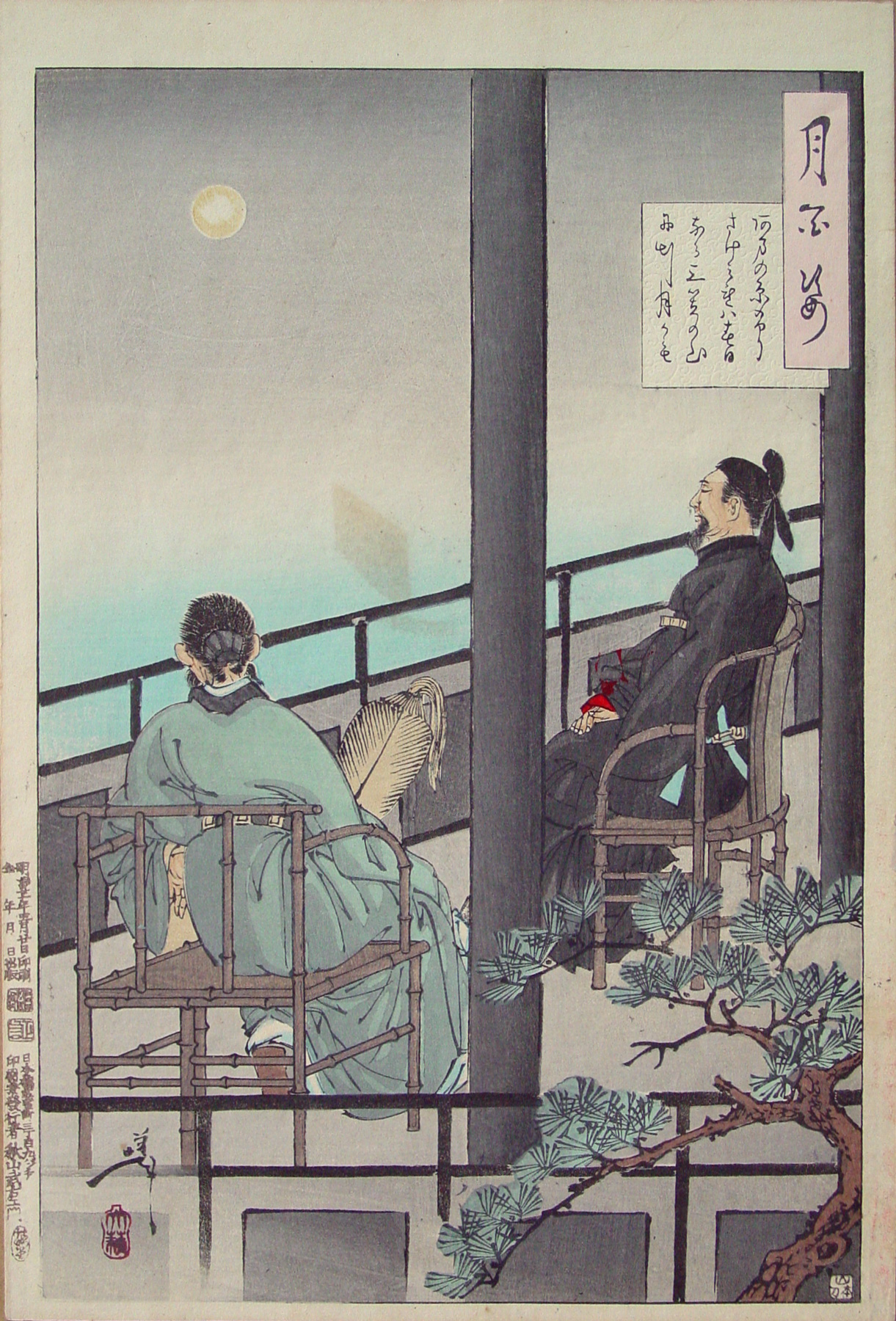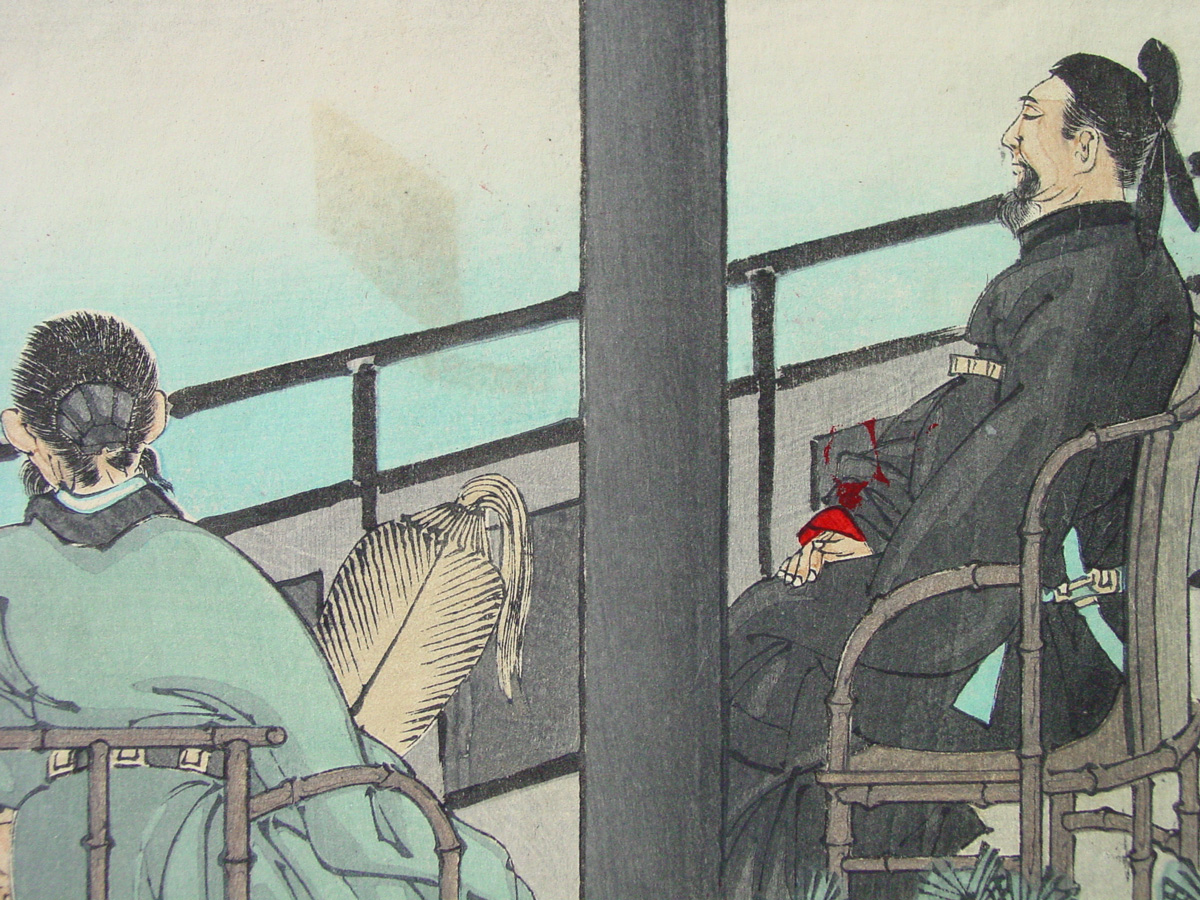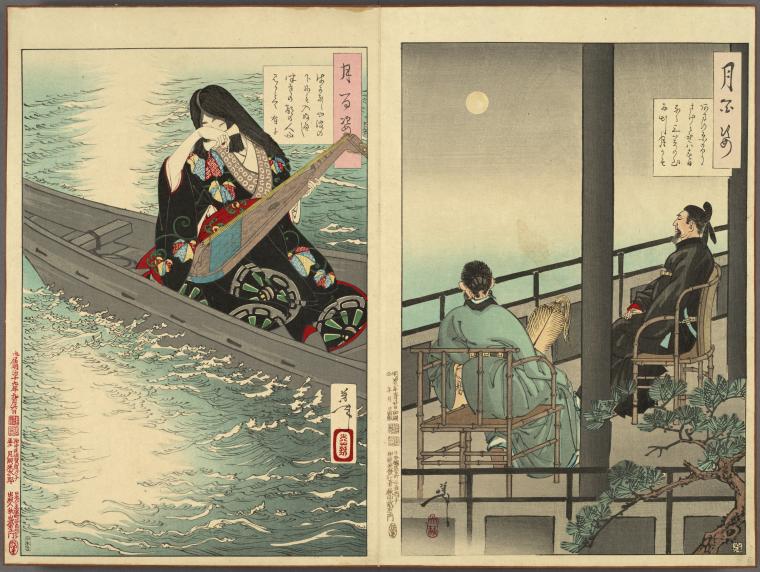About This Print
Source: Museum of International Folk Art http://www.internationalfolkart.org/exhibitions/past/moonweb/section2/045.htm
Abe no Nakamaro (A.D. 701-770) was sent to China to study and remained there until he died. One night he composed this poem to express his homesickness for Japan, As I look out into the vast expanse, can this be the same moon that I saw rise in Kasuga behind Mount Mikasa?
This print is from the album issued by publisher Akiyama Buemon shortly after Yoshitoshi's death and retains its original album backing. The faint diamond-shaped object to the left of the central pillar is seen on all copies of this print included in the album, as it is an offset from the image of the lute on the print on the facing page as seen below.
The Story Depicted in the Print as Told by John Stevenson
Source: Yoshitoshi's One Hundred Aspects of the Moon, John Stevenson, Hotei Publishing, Netherlands 200164.
As I look out into the vast expanse
Can this be the same moon
That I saw rise in Kasuga behind Mount Mikasa?
ama no hara
furisake mireba
Kasuga naru
Mikasa no yama ni
ideshi tsuki kamo
Abe no Nakamaro (701-770) wrote this poem, which is often quoted to express an expatriate’s homesickness. The poem was included in the much illustrated Hyakunin isshu, One Hundred Poems by One Hundred Poets, complied by Fujiwara no Teika in the thirteenth century; it is so well known that Yoshitoshi has not bothered to mention the name of the poet in the cartouche. Kasuga temple and Mount Mikasa are famous landmarks in Nara, an ancient city south of Kyoto which in the eight-century was the capital of Japan.
When he was a boy at the Nara court, Nakamaro showed great promise as a mathematician. At the age of sixteen he was chosen to join a mission to the Tang court in China, to study Chinese methods of measuring time. He stayed in China for thirty years, before falling out of favor with the Chinese emperor. He was imprisoned for a time in a tower, where, in despair, he wrote his famous poem, some say in blood.
In 753 Nakamaro attempted to return to Japan, but was blown off course and shipwrecked off the coast of Vietnam. He made his way back to Chang’an, the Tang capital. A few years later he was appointed governor of northern Vietnam, at that time a protectorate of Tang China. He fulfilled his duties well, and in 766 received an imperial commendation for pacifying a rebellion on the Yunnan border.
He never managed to return to Japan, unlike a friend named Kibi no Makibi who accompanied him on the original mission. Kibi is often associated with Nakamaro in illustration and drama, and may be the man seated beside him in this design. Kibi returned home in 735, taking with him the art of embroidery, the game of go (a soft of chess still very popular today), and the biwa (a form of lute). In the Kabuki play, Kin’u gyokuto wakoku no irifune, The Golden Crow, the Jade Rabbit, and the Ship that Arrives from Japan, Nakamaro’s spirit communicates the secrets of the Chinese almanac to Kibi, far away in Japan.
Nakamaro’s story is an interesting example of early official contact between Japan and China. Travel between the two countries was not easy: disorder in the Korean peninsula often made the overland route difficult, while the journey by sea in the tiny boats of the period was extremely dangerous. Nineteen missions left Japan for Tang China in the years between 630 and 894, after which official missions were abandoned.
Although this design does not have the charm of, for example, Hokusai’s several illustrations of Nakamaro’s story, it effectively uses the device of the pillar in the center of the composition to suggest Nakamaro’s painful isolation. The device is doubly effective if the companion is Kibi before he returned to Japan, demonstrating the separation of the two friends and foreseeing them both gazing at the moon while one is in China and the other in Japan.
Can this be the same moon
That I saw rise in Kasuga behind Mount Mikasa?
ama no hara
furisake mireba
Kasuga naru
Mikasa no yama ni
ideshi tsuki kamo
Abe no Nakamaro (701-770) wrote this poem, which is often quoted to express an expatriate’s homesickness. The poem was included in the much illustrated Hyakunin isshu, One Hundred Poems by One Hundred Poets, complied by Fujiwara no Teika in the thirteenth century; it is so well known that Yoshitoshi has not bothered to mention the name of the poet in the cartouche. Kasuga temple and Mount Mikasa are famous landmarks in Nara, an ancient city south of Kyoto which in the eight-century was the capital of Japan.
When he was a boy at the Nara court, Nakamaro showed great promise as a mathematician. At the age of sixteen he was chosen to join a mission to the Tang court in China, to study Chinese methods of measuring time. He stayed in China for thirty years, before falling out of favor with the Chinese emperor. He was imprisoned for a time in a tower, where, in despair, he wrote his famous poem, some say in blood.
In 753 Nakamaro attempted to return to Japan, but was blown off course and shipwrecked off the coast of Vietnam. He made his way back to Chang’an, the Tang capital. A few years later he was appointed governor of northern Vietnam, at that time a protectorate of Tang China. He fulfilled his duties well, and in 766 received an imperial commendation for pacifying a rebellion on the Yunnan border.
He never managed to return to Japan, unlike a friend named Kibi no Makibi who accompanied him on the original mission. Kibi is often associated with Nakamaro in illustration and drama, and may be the man seated beside him in this design. Kibi returned home in 735, taking with him the art of embroidery, the game of go (a soft of chess still very popular today), and the biwa (a form of lute). In the Kabuki play, Kin’u gyokuto wakoku no irifune, The Golden Crow, the Jade Rabbit, and the Ship that Arrives from Japan, Nakamaro’s spirit communicates the secrets of the Chinese almanac to Kibi, far away in Japan.
Nakamaro’s story is an interesting example of early official contact between Japan and China. Travel between the two countries was not easy: disorder in the Korean peninsula often made the overland route difficult, while the journey by sea in the tiny boats of the period was extremely dangerous. Nineteen missions left Japan for Tang China in the years between 630 and 894, after which official missions were abandoned.
Although this design does not have the charm of, for example, Hokusai’s several illustrations of Nakamaro’s story, it effectively uses the device of the pillar in the center of the composition to suggest Nakamaro’s painful isolation. The device is doubly effective if the companion is Kibi before he returned to Japan, demonstrating the separation of the two friends and foreseeing them both gazing at the moon while one is in China and the other in Japan.
About the Series "One Hundred Aspects of the Moon"For details about this series which consists of one hundred prints with the moon as a unifying motif, see the article on this site Yoshitoshi, One Hundred Aspects of the Moon.
Print Details
| IHL Catalog | #83 |
| Title | Abe no Nakamaro - Kasuga Moon (阿倍仲麻呂) |
| Series | One Hundred Aspects of the Moon (Tsuki hyaku sugata 月百姿) |
| John Stevens Reference No.* | 64 |
| Artist | Tsukioka Yoshitoshi (1839-1892) |
| Signature | Yoshitoshi 芳年 |
| Seal | Taiso 大蘇 |
| Date | May 20, 1888 (明治廿一年五月廿日印刷 仝年 月 日出版) |
| Edition | From the album issued by publisher shortly after Yoshitoshi's death |
| Publisher | Akiyama Buemon (秋山武右エ門) [Marks: seal 26-132; pub. ref. 005] |
| Carver | Yamamoto tō 山本刀 [Yamamoto Shinji] |
| Impression | excellent |
| Colors | excellent |
| Condition | good - backed with album paper, slight margin trimming not effecting image or information written in margin, minor soiling, triangular offset stain caused by facing print in album. |
| Genre | ukiyo-e |
| Miscellaneous | |
| Format | oban |
| H x W Paper | 14 x 9 1/2 in. (35.6 x 24.1 cm) |
| H x W Image | 13 x 8 3/4 in. (33 x 22.2 cm) |
| Collections This Print | Smithsonian National Museum of Asian Art S2003.8.3041; The British Museum 1906,1220,0.1435; The New York Public Library Humanities and Social Sciences Library / Spencer Collection Digital Image ID: 1269834 Digital Record ID:674341; Yale University Art Gallery 2011.143.1.64; Uregami Hagi Museum U01566; The Tsubouchi Memorial Theatre Museum of Waseda University 201-4508; Ritsumeikan University ARC NDL-541-00-048 and NDL-223-00-026; Tokyo Metropolitan Library 加4722-39 |
| Reference Literature | * Yoshitoshi’s One Hundred Aspects of the Moon, John Stevenson, Hotei Publishing, Netherlands 2001, pl. 64. |




